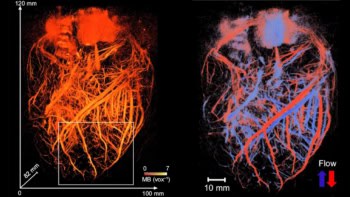
A round-up of the latest international patent applications in medical imaging.
Ultrasound offers three-in-one visualization
Supersonic Imagine has devised an ultrasound technique that combines three types of images into a visualization image (WO/2018/046740). The method comprises emission and reception of sequences of temporally interleaved ultrasound waves, and a step during which the received sequences are processed to generate three images via three different process. The visualization image is then determined by combining the three images, for example by superimposing the second and third images over the first. In one aspect, the first process is B-mode ultrasound imaging, the second is elastography ultrasound imaging and the third is flow process imaging. This approach enables the user to identify the relationship between the three types of images, as well as reducing the examination time and improving diagnostic accuracy.
Radiomic features determine immunotherapy response
Researchers from Case Western Reserve University have developed apparatus that can predict a patient’s response to immunotherapy from CT images of a tissue region demonstrating non-small cell lung cancer (WO/2018/017355). In one example, the apparatus includes a series of circuits that: access the CT image of a tissue region demonstrating cancerous pathology; generate a tumoural surface boundary defining a tumour volume; generate a peri-tumoural region based on the surface boundary, and segment this region into annular bands; and extract a set of discriminative features from the tumour volume and at least one annular band. Finally, a circuit classifies the region-of-interest as a responder or a non-responder, based at least in part on the set of discriminative features.
D-Histo differentiates inflammation from solid tumours
Washington University researchers have created D-Histo, a non-invasive diagnostic method for quantitatively distinguishing inflammation and injury from solid tumours (WO/2018/045066). One example utilizes diffusion-weighted MRI to provide an accurate diagnosis of prostate cancer, distinguishing it from prostatitis and enlarged prostate, which can be missed by current diagnostic methods. The D-Histo method can also provide metrics to reflect reversible versus irreversible damage in heart and central/peripheral nerves. For central and peripheral nerves, D-Histo also provides metrics to assess nerve functionality. The D-Histo biomarker(s) obtained using diffusion-weighted MRI have excellent test-retest stability, high sensitivity to disease progression and close correlation with current techniques.
Electrodes suit metal-sensitive neurological monitoring
Rhythmlink has invented an electrode assembly for metal-sensitive neurological monitoring using methods such as CT and MRI (WO/2018/013751). Monitoring electrodes are employed to obtain signals from the brain. The assembly includes lead wires of at least 39-gauge copper electrical conductors, free of tin, in PVC insulation attached to electrodes. The electrodes, which may also be copper or made of metal-filled plastic, are attached to lead wires by either: crimping using copper or polymer crimps; shrink-wrap connections or ties; or radio frequency welding or heat staking. This electrode assembly reduces temperature increases during CT and MRI procedures, and minimizes the presence of artefacts in the resulting images.
Spectral CT fingerprints tissue types
Philips has published details of a spectral CT fingerprinting technique (WO/2018/011321). The method includes generating spectral projection data of a subject, including at least one projection corresponding to a first energy range and one to a second energy range. The approach involves constructing an image from a combination of the spectral projection data, and constructing a set of basis images for the energy ranges. The filing also describes the construction of a multi-dimensional histogram from the set of basis images, which includes at least two axes, corresponding to each basis component. This multi-dimensional histogram includes a set of clusters, including one for each material or tissue type represented in the spectral projection data. The approach could enable identification of a number of tissues, including known normal and abnormal tissue of a particular type.
Transformable gamma camera maximizes efficiency
A transformable gamma camera is described by eV Products in patent application WO/2018/031584. The filing details how a large gamma camera can be subdivided into two or more smaller gamma cameras, each independently positioned for SPECT data acquisition. These transformable gamma cameras make more efficient use of the gamma photon detector area. Tiled arrays of semiconductor gamma detectors are especially suited for such transformation.



